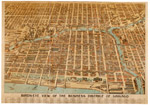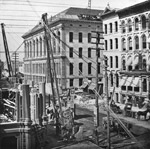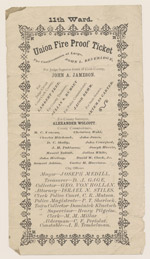Queen of the West Once More
The capitalists, the mercantile and business interests of this country and of Europe cannot afford to withhold the means to rebuild Chicago.... What she has been in the past she must become in the future, and a hundred fold more.
William Bross, Speech to the New York Chamber of Commerce
Burnt out of his home, William Bross expended little energy on self-pity. Chicago's future was at risk, and there was no time to lose. The fire ended at dawn on Tuesday, October 10, and by Thursday evening he was on a train to New York. Upon his arrival, Bross spoke to reporters eager for eyewitness reports, and soon after he addressed local businessmen. His message was direct and upbeat: the fire opened rather than foreclosed opportunities to invest in his city. New York, "the senior partner" in American enterprise to "junior partner" Chicago, could not "sit by and see the business of the firm crushed out when he has the means to establish it on a scale more gigantic and more profitable than ever before." John Stephen Wright, the king of Chicago boosters, who had ceaselessly promoted the city's prospects over the previous four decades, offered an even more optimistic prediction: "Five years will give Chicago more men, more money, more business, than she would have had without this fire." Wright followed this with the colorful observation, "Chicago is not burnt up, only well blistered for bad ailments, to strengthen her for manhood."
This talk of Chicago as a junior partner and as approaching manhood emphasized that the fire had done nothing to damage the city's most important quality, its apparently unlimited potential for equally unlimited growth. And, whether they were speaking from concern or from confidence, both Bross and Wright prophesied true. Industrializing America had too much invested in Chicago's development, and the features that made that development possible--the city's location and its resources (including human resources)--were still very much in place.
After a brief downturn in the financial markets and an even briefer moment of doubt about the future on the part of some Chicagoans, the rebuilding began in earnest. Within days a few businesses sprang up in stands and sheds among the ruins, and traffic started moving again. The rubble was swept away, a good portion of it pushed into the lake to make new real estate. Basic services were quickly reestablished in temporary quarters--the post office, for example, was set up in a Methodist church on the corner of Wabash and Harrison. Inside of six weeks, work had begun on 212 stone and brick buildings in the South Division alone.
Visitors were soon struck by a new Chicago that a local journalist described as "better classified, and its future more distinctly marked, than could have been possible before the fire." The flames had spurred changes already in progress in the pre-fire city by clearing the way for the doubling of the size of the downtown and the construction of taller buildings in this area, as well as more distinct divisions by type in the location of businesses. Commercial and residential districts likewise became more sharply separated from each other, as Chicagoans of all income levels moved farther from the central city and into neighborhoods that were more clearly distinguished from one another than they had been previously.
What was called the "Great Rebuilding" involved more than physical reconstruction. Mayor Mason designated Sunday, October 29, "as a special day of humiliation and prayer; of humiliation for those past offenses against Almighty God, to which these severe afflictions were doubtless intended to lead our minds; of prayer for the relief and comfort of the suffering thousands in our midst; for the restoration of our material prosperity, especially for our lasting improvement as a people in reverence and obedience to God." While such occasions were meant to comfort the soul of the city, other developments focused on its political well-being. In the November mayoral election, Chicagoans voted in Tribune co-owner Joseph Medill on the Union Fire Proof ticket, which was pledged to cleaner government and stricter building codes.
But Chicago's resurrection was a good deal bumpier than the booster vision admitted. The fire suddenly rearranged many lives, wiping out one person's home and assets while creating new possibilities for another. As is almost always the case following a disaster, the poor endured more hardships than the rich. In mid-January of 1872 an angry group of demonstrators carrying placards with such slogans as "Leave a Home for the Laborer" and "Don't Vote Any More for the Poor Man's Oppressor" broke up a meeting of the Common Council. The protesters opposed pending restrictions on flammable building materials as discriminating against those who could only afford wood. Working people were caught in other binds, as landlords and employers saw no contradiction in their charging higher rents because of the housing shortage as they appealed to laborers to hold the line on wages. Workers who attempted to organize--there was a failed strike by carpenters and a successful one by bricklayers in the fall of 1872--found themselves attacked in some newspapers as enemies of the common good. The influx of newcomers seeking opportunities for work in rebuilding Chicago worsened the situation by keeping down the price of labor while raising rents.
There were other difficulties and conflicts. The rapid pace of rebuilding, assisted by the innovative use of derricks, led to a high number of injuries and deaths on the job. To add insult to such injuries, a group of native-born reformers, ever fearful of social disorder, focused on alcohol as the root of all evil. They successfully pressured Mayor Medill to enforce an existing ban on Sunday drinking, which Chicagoans of Irish and German extraction correctly took as an attack on the saloons and beer halls in which they socialized. As Chicago politics became more embattled, Medill left for Paris well before his term was up. In the fall of 1873, Harvey Colvin, the native-born standard-bearer of a new coalition of ethnic voters that called itself the People's Party, was elected over the "reform" candidate.
The period of the Great Rebuilding came to a close with the Panic of 1873, which proved to be a more serious detriment to the local economy than the fire. By December the unemployed were chanting "Bread or death" outside the offices of the Relief and Aid Society, which once again refused to accede to demands to turn the balance of its funds over to the city. Not long after, in July of 1874, another fire struck the city. It started in the 400 block of South Clark Street and advanced north and east, destroying about fifty acres and over eight hundred buildings. Soon a threatened boycott of Chicago property by insurers compelled the city to adopt stricter safety codes and improve the fire department.
Some commentators who tried to take a broader view of the Great Fire and the Great Rebuilding expressed concern that the losses, large as they were, were more profound and less easily calculated than at first appeared. Impatient even before the fire with the slow development of refinement in the "junior partner," they were discouraged by the prospect that the need to rebuild would only delay Chicago's cultural growth. Most of the population had little time for such reflections. The population topped 500,000 by 1880, more than a million a decade later. By the late spring of 1873, the city was ready to celebrate its recovery, hosting a jubilee week in June. In the same year its business leaders, including several who served on the board of the Relief and Aid Society, hosted the Inter-State Industrial Exposition in an enormous new building on the lakefront. Chicago, as an inspirational post-fire song went, was "Queen of the West Once More."










